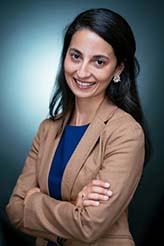AHA FIT Newsletter
Virtual Cardiovascular Disease Fellowship Recruitment: Looking Back to Inform the Future

Nosheen Reza, MD
Assistant Professor Medicine
Division of Cardiovascular Medicine
Hospital of the University of Pennsylvania & the Perelman School of Medicine at the University of Pennsylvania
We are heading into the home stretch of the second year of virtual interviews for cardiovascular disease fellowship, and it is remarkable to think about how dramatically fellowship programs have transformed their recruitment practices to accommodate our remote world. In September 2020, Drs. Kathryn Berlacher, John McPherson, Nadeen Faza, and I anticipated some of the challenges of and proposed potential solutions for an unprecedented fully virtual recruitment season in our manuscript published in JACC: Case Reports. We emphasized the importance of ensuring authentic interactions between applicants and fellows on interview days, remaining mindful of the unique challenges that applicants have endured as frontline clinicians during the COVID-19 pandemic, and embedding structures to mitigate bias and promote equity in the application, interview, and selection processes. So, what lessons are we taking forward into the 2021 recruitment season?
With the transition to virtual interviews, a primary concern of applicants and educators was “application bloat” or “interview hoarding” — a significant increase in the number of applications submitted by individual applicants and therefore to each individual program. Data from the Association of American Medical Colleges Electronic Residency Application Service shows us that the number of applicants to Cardiovascular Disease fellowship continued to rise in 2020 with 353 individuals who applied to U.S. MD-granting public schools, 280 applicants to U.S. MD-granting private schools, 189 applicants to U.S. DO-granting schools, 771 applicants to international programs, and 1 applicant to a Canadian program. Approximately 30% of applicants in 2020 were women, which is essentially unchanged from 2016. The proportion of White applicants increased to 42% in 2020, from 38% in 2019, while the proportions of Black or African American; Asian; Hispanic, Latino, or of Spanish origin; Native Hawaiian or other Pacific Islander; American Indian or Alaska Native applicants remained essentially the same. As expected, the number of to which programs each applicant applied increased with the average numbers of applications per applicant reaching their highest numbers in 5 years — 51.5 applications per those applying to U.S. MD-granting public schools, 46.2 per those applying to U.S. MD-granting private schools, 62.4 per those applying to U.S. DO-granting schools, 105.1 per those applying to international programs, and 82.0 per those applying to Canadian programs. Anecdotally, program directors have reported similar or better match outcomes compared to pre-COVID-19 years with more applicants from diverse backgrounds. These trends will certainly be of interest again this year, and this highlights the need for cardiology-specific data to guide the future of virtual recruitment and to ensure equity.
While we await objective assessments of the virtual cardiovascular disease interview process, we have learned that creating structures to help prepare applicants for the virtual interview format through a mock interview can improve their preparedness, comfort, and confidence. My colleagues and I presented our work on this topic at an international scientific congress earlier this year and found that mock interviews are effective tools in preparing residents applying to cardiovascular medicine fellowship and provide an opportunity for mentorship of traditionally underrepresented populations in cardiology including women, foreign medical graduates, and non-White applicants. We are further evaluating these findings with an expanded mock interview initiative this year.
Finally, we have learned how to successfully leverage technology to create inventive resources for virtual recruitment. Many programs have revamped their websites, also often incorporating video testimonials from current fellows and engaging on social media, to highlight unique aspects of their training programs. Programs often reformatted the standard interview-day informational presentations into asynchronous materials that applicants could review on their own time, reserving the interview day itself for meaningful one-on-one interactions between applicants and faculty and applicants and fellows. The financial and time commitments required to interview for fellowship have also been dramatically reduced, contributing to a reimagined applicant-centered process.
While many uncertainties regarding the COVID-19 pandemic remain, we are hopeful that a return to some degree of in-person academic activity will occur in 2022. Given the anecdotal success of the virtual recruitment process to date, we are looking forward to seeing how the cardiovascular education community and graduate medical education governing bodies reach consensus on the process for the 2022 fellowship recruitment season.